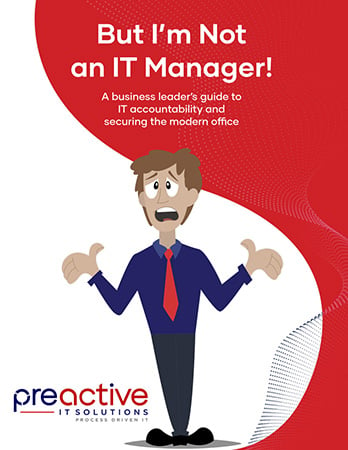
By Charles Swihart, Founder and CEO of Preactive IT Solutions
February 28, 2025
As the Founder and CEO of Preactive IT Solutions, I’ve spent more than two decades watching businesses wrestle with the intersection of technology and trust. Today, cybersecurity is no longer just a technical necessity—it’s a foundational element of brand reputation and customer loyalty.
In a world where data breaches dominate headlines and consumers are more skeptical than ever, a strong cybersecurity posture can set your business apart as a trusted partner. This isn’t about fear-mongering or empty assurances—it’s about understanding the mechanics of trust, the consequences of breaches, and how to proactively communicate your security efforts.
Let’s break it down.
The Direct Link Between Cybersecurity, Trust, and Customer Loyalty
Trust is the currency of modern business. Whether your customers are engineering firms relying on you for managed IT services or individual consumers making online purchases, they expect their data to be handled with precision and integrity.
A 2023 IBM Security report pegged the average cost of a data breach at $4.45 million, but the financial hit is only part of the damage. The real threat is the erosion of customer confidence. According to the National Cybersecurity Alliance, 60% of small businesses lose customers permanently after a data breach.
On the flip side, businesses that prioritize cybersecurity enjoy a competitive advantage. A PwC survey found that 87% of consumers are more likely to do business with organizations that demonstrate strong data protection. Cybersecurity builds loyalty, credibility, and peace of mind—all of which drive long-term customer retention.
How Security Drives Customer Loyalty
Consider an engineering firm that entrusts us with proprietary designs and project data. If we fail to protect their intellectual property against ransomware or insider threats, we don’t just lose a client—we jeopardize their competitive edge.
By implementing layered security defenses—including endpoint protection, encrypted backups, and real-time threat monitoring—we don’t just protect their data; we reinforce their trust. That trust translates into repeat business and referrals—the lifeblood of any service-driven company.
Customers don’t need to understand the intricacies of zero-trust architecture or multi-factor authentication (MFA). They simply need to know their information is safe. When you consistently demonstrate that commitment to security, you’re no longer just a vendor—you become a strategic partner.
At Preactive IT Solutions, we’ve seen this play out firsthand with clients who have stayed with us for years, citing our proactive security measures as a key reason.
The Fallout of Data Breaches: Reputation Under Fire
Now, let’s look at the other side of the coin. A data breach doesn’t just compromise systems—it can destroy a company’s reputation in a matter of hours.
The 2017 Equifax breach exposed the personal data of 147 million people, resulting in:
 A 34% stock drop within a week
A 34% stock drop within a week
 $700 million in fines
$700 million in fines
 A public relations nightmare that lingers to this day
A public relations nightmare that lingers to this day
Smaller companies aren’t immune. A local retailer we consulted suffered a ransomware attack in 2022, leaking customer credit card data. Within months, their online reviews tanked, foot traffic dropped 40%, and they spent six figures on legal fees and remediation.
Why Data Breaches Are So Damaging
Reputation damage from a breach comes from three critical factors:
- Public Visibility: High-profile incidents spread like wildfire on social media, where users dissect every misstep.
- Perceived Negligence: If customers or regulators believe you ignored security best practices, the backlash is even worse.
- Loss of Control: Once sensitive data is exposed, there’s no taking it back—competitors and cybercriminals capitalize on the chaos.
The Ponemon Institute found that 65% of breached companies see a sustained decline in brand value, with recovery taking 12-18 months—if it happens at all.
How Businesses Can Recover from a Cybersecurity Breach
Recovery isn’t impossible, but it’s an uphill battle. Here’s how we guide clients through post-breach damage control:
1. Containment
 Isolate the breach, patch the exploited vulnerability, and deploy forensic tools to assess the full impact.
Isolate the breach, patch the exploited vulnerability, and deploy forensic tools to assess the full impact.
 Use platforms like CrowdStrike for real-time threat monitoring—it’s not cheap, but it’s precise.
Use platforms like CrowdStrike for real-time threat monitoring—it’s not cheap, but it’s precise.
2. Transparency
 Notify affected parties immediately, even before regulators require it. Silence breeds distrust.
Notify affected parties immediately, even before regulators require it. Silence breeds distrust.
 Own up to the breach and explain the corrective actions you’re taking.
Own up to the breach and explain the corrective actions you’re taking.
3. Remediation
 Offer tangible support—credit monitoring for individuals, system audits for B2B clients.
Offer tangible support—credit monitoring for individuals, system audits for B2B clients.
 Strengthen your security framework to prevent future incidents.
Strengthen your security framework to prevent future incidents.
4. Prove Your Commitment to Security
 Publish a post-mortem report detailing what happened and how your company has improved security.
Publish a post-mortem report detailing what happened and how your company has improved security.
 Showcase your investments in cybersecurity (like Target did after its 2013 breach).
Showcase your investments in cybersecurity (like Target did after its 2013 breach).
But here’s the harsh reality: recovery costs dwarf prevention. A single breach can consume a company’s IT budget for years, money that could’ve gone toward proactive security.
Communicating Cybersecurity to Customers, Employees, and Partners
Having strong cybersecurity is only half the battle—you need to effectively communicate it to stakeholders. But this isn’t about slapping a “We’re Secure!” badge on your website.
How to Build Trust Through Security Transparency
 Tailor Your Message
Tailor Your Message
- For engineering firms: Highlight how you secure CAD files with AES-256 encryption.
- For retailers: Emphasize PCI DSS compliance and fraud protection measures.
 Demonstrate Security in Action
Demonstrate Security in Action
- Use hard data: “Our systems blocked 1,200 threats last quarter.”
- Host webinars or send newsletters on cybersecurity trends—educate, don’t sell.
 Flaunt Your Credentials
Flaunt Your Credentials
- ISO 27001, SOC 2, or other certifications? Showcase them!
- Have you successfully mitigated an attack? Share the story (without arrogance).
 Empower Employees as Security Advocates
Empower Employees as Security Advocates
- Train staff on phishing detection—91% of cyberattacks begin with a phishing email (Verizon DBIR 2023).
- Let employees evangelize your culture of security—they’re your best brand ambassadors.
At Preactive IT Solutions, security is part of our brand narrative. We don’t just “provide IT services”—we “empower businesses with secure, reliable technology.” When clients praise our security measures, that’s cybersecurity enhancing brand reputation in real-time.
The Bottom Line: Cybersecurity as a Business Differentiator
Cybersecurity isn’t just an IT concern—it’s a strategic asset.
 It builds trust by proving you take customer data seriously.
It builds trust by proving you take customer data seriously.
 It fuels loyalty by reducing risk and friction in business operations.
It fuels loyalty by reducing risk and friction in business operations.
 It prevents costly breaches that could tarnish your reputation permanently.
It prevents costly breaches that could tarnish your reputation permanently.
At Preactive IT Solutions, we’ve seen firsthand that firms investing in cybersecurity don’t just survive—they thrive. Because in today’s business world, trust isn’t negotiable.
If you’re ready to make cybersecurity a pillar of your brand, start with an audit. Identify weaknesses, fortify your defenses, and make security a core part of your company’s identity. The payoff? Not just safety—but a brand reputation that stands the test of time.
Let’s Talk About Your Cybersecurity Strategy
📞 Call us today: (832) 944-6250
Your customers trust you. Let’s make sure your cybersecurity strategy keeps it that way.
Charles Swihart
CEO, Preactive IT Solutions
Charles Swihart has been at the forefront of the
Managed IT Services industry since founding
Preactive IT Solutions in 2003.




